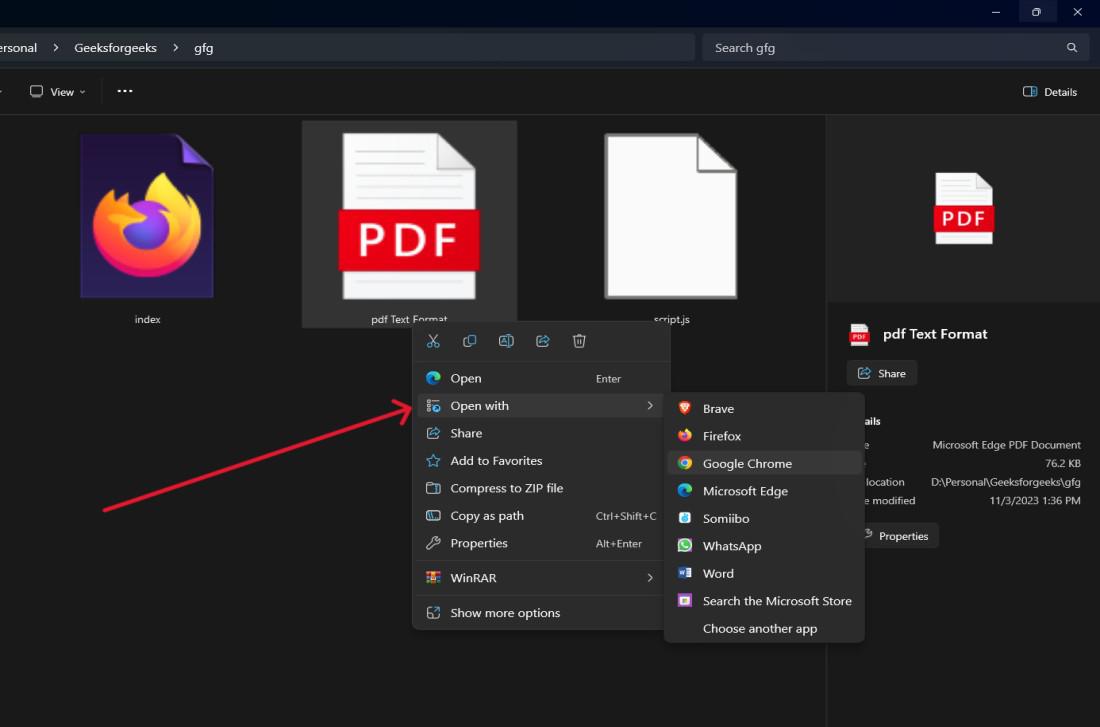PDF File Format
Last Updated :
13 Nov, 2023
PDF, which means a portable document, is a ubiquitous format. The PDF file format was developed by Adobe in the early 1990s, and it is a must-have tool for communicating, viewing, and archiving document copies. In this article, we will delve into the world of PDF text files, exploring what they are, their uses, how to open and create them, their benefits, applications that rely on this format, and a concluding overview.
What is the PDF text format?
A PDF text file is a well-recognized file that incorporates text, graphics, typefaces, and page designs, independent of OS, platform, and application. The first format was created to ensure that a document appeared the same on any device, meaning that its content remained true when shared. PDFs can be generated from many different sources, such as word processing, spreadsheet applications, and even simple scanned material, making them ideal for both electronic-based publications and paper-based materials.
Uses of PDF Text Files
PDF text files serve a wide range of purposes, including:
- Document Sharing: Sharing documents whose formatting and appearance should remain consistent across devices is most suitably done via PDFs.
- Archiving: Through the use of PDFs, they create digital archives for important documents, which then provide a stable and long-term storage option.
- Forms: Many applications, including job applications and surveys, are nowadays being completed by interacting with PDF forms.
- Ebooks: The majority of ebooks are given in a PDF format so that the content remains the same on different e-readers.
- Legal Documents: For instance, PDFs are used to present legal contracts, agreements, and court filings so that they maintain their authenticity and layout.
How to Open PDF Text Files
For instance, opening a PDF text file is straightforward since there are special readers optimized for different OSs and devices. Some of the best-known PDF viewers include Adobe Acrobat Reader for starters, along with free options like Foxit Reader, Sumatra PDF, and online applications such as Google Drive and Edge by Microsoft.
- To open a PDF, double-click the file, type, or click on Open, where you can select whatever software you want to open with.

How to Create PDF Text Files
Creating a PDF text file can be done using various methods:
- Using PDF Creation Software: Many software applications are available for transforming your documents into PDFs. These include Microsoft Word, Google Docs, and Adobe Acrobat, among others.
- Online Converters: Various online tools are available, making it easy to convert different types of files into PDF formats.
- Print to PDF: You can print a document to PDF on Windows using the built-in Microsoft Print to PDF feature or save documents as PDFs on Mac directly from the Print dialog.
Step 1: To create a PDF file open MS Word then write some content and then click on File:

Step 2: From Save as Type dropdown select PDF to save the file as a .pdf

Benefits of the PDF Text File Format
PDF text files offer several advantages, including:
- Universal Compatibility: Your document is likely to open anywhere, and it will always appear the same as it did on PDF.
- Security: Sharing confidential information may be done through the use of password-protected, encrypted, and digitally signed PDFs.
- Maintains Formatting: PDFs help to retain their format, fonts, and graphics without being opened by any other software.
- Compact File Size: The quality is preserved even when the PDFs are optimized for efficient storage or sharing.
Applications That Use PDF Text Files
PDF text files are widely used in various industries and sectors, such as:
- Business: They often distribute reports, invoices, and contracts in PDF form.
- Education: Research papers, lecture notes, and study materials are sometimes distributed as PDF documents.
- Healthcare: PDFs ensure the security of medical records, prescriptions, and other patient materials.
- Publishing: The consistency in layout makes PDF a common medium for the publication of magazines, catalogs, and electronic books.
- Government: To maintain uniformity and precision, official documents, tax forms, and regulations are provided in PDF.
Conclusion
In the digital era, the PDF file format has transformed the manner in which we exchange, retain, and showcase documents. Thanks to their wide-ranging accessibility, protective characteristics, and capacity to uphold layout, PDF files have seamlessly blended into our personal and occupational existences. No matter if you are a student, a corporate executive, or a public department, the adaptability and trustworthiness of PDFs serve as an essential mechanism for overseeing and disseminating data in today’s interconnected domain.
Share your thoughts in the comments
Please Login to comment...